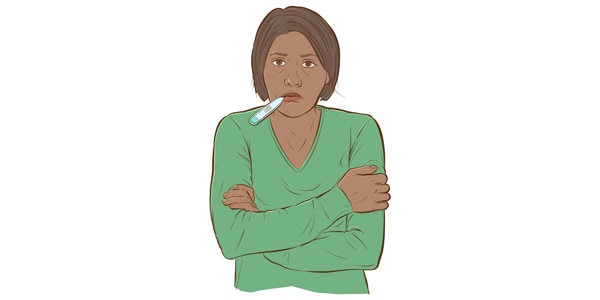Key points
- Common symptoms of anaplasmosis are fever, headache, and malaise. Symptoms vary.
- Symptoms typically begin within 5-14 days after an infected tick bite; however, many people will not remember a bite.
- Mild or moderate symptoms are most common. Severe illness can develop.
- Polymerase chain reaction (PCR) is the most accurate means of confirming diagnosis early in the illness. Blood tests such as complete blood cell count, and a complete metabolic profile can support the diagnosis.

Early Illness
Common signs and symptoms
Signs and symptoms commonly seen early in the illness course (days 1-5) include:
- Fever, chills, rigors
- Severe headache
- Malaise
- Myalgia
- Gastrointestinal symptoms (nausea, vomiting, diarrhea, anorexia) in about 20% of cases
Common laboratory abnormalities include elevated aminotransferase levels, leukopenia, and thrombocytopenia.
Uncommon or rarely reported symptoms
- Rash in patients with anaplasmosis. The presence of a rash might indicate a coinfection with Borrelia spp, or another tickborne disease.
- Nervous system involvement (e.g., meningoencephalitis, focal paralysis, etc.).
Severe Disease
When treatment is delayed
If treatment is delayed or patients do not receive care, they may develop severe disease. Severe illness is rare, but may involve:
- Renal or respiratory failure
- Peripheral neuropathies
- Disseminated intravascular coagulation (DIC)-like coagulopathies
- Rhabdomyolysis
- Hemorrhage
Severe disease risk factors
- Delayed antibiotic treatment
- Younger than 5 years of age or older than 65 years of age
- Immune compromising conditions, e.g., persons with advanced HIV, persons receiving chemotherapy, or persons receiving other immune-suppressing medications
Clinical Course
The clinical course varies from person to person. It depends on:
- Patient age
- Co-morbid conditions
- Immune status
- Timing of treatment initiation relative to illness onset.
Patients who are treated early may recover quickly with outpatient antibiotic treatment. Those who experience a more severe course might require hospitalization and/or intensive care.
More in-depth information
For more in-depth information about signs and symptoms of anaplasmosis: Diagnosis and Management of Tickborne Rickettsial Diseases: Rocky Mountain Spotted Fever and Other Spotted Fever Group Rickettsioses, Ehrlichioses, and Anaplasmosis — United States: A Practical Guide for Health Care and Public Health Professionals (2016)
Laboratory Testing
Healthcare providers should consider results from laboratory tests, such as a complete blood cell count and a complete metabolic profile when making the diagnosis.
- Abnormal laboratory findings can include mild anemia, thrombocytopenia, leukopenia (both relative and absolute lymphopenia) and mild to moderate elevations in hepatic transaminases.
- Abnormal laboratory findings can appear in the first week of illness; however, normal laboratory findings do not rule out possible infection.
